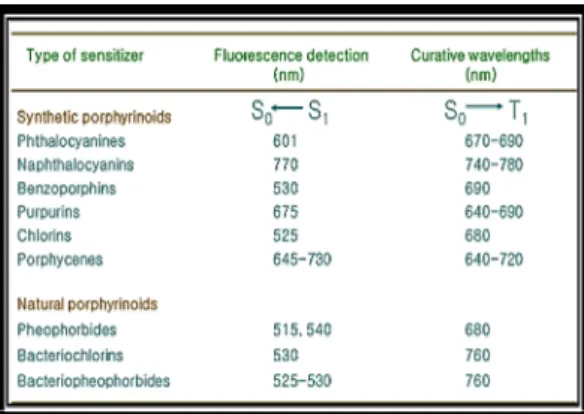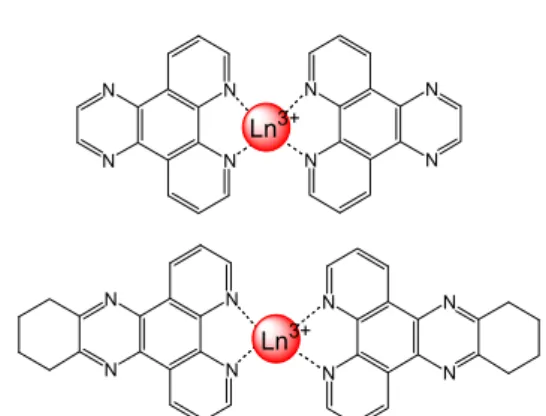I. Introduction
The photobiological active molecular model for photodynamic therapy has been attracted as a research for the development of cancer treatment, and more functionalized molecular models have been developed for the research of smart and stable photobiological active molecule systematically [1].
In addition, these systematical researches have been competed on the clinical and molecular level all over the world. Until now, every developed photosensitizer for photodynamic therapy (PDT) showed photosensitivity and side effect of the skin part for human, and the development of photosensitizer having more smart and less photosensitivity for human has been demanded.
Furthermore, the research of the stable photosensitizing molecule showing the longer wavelength and longer life time has been also tried for the development of photodynamic therapy. I have been researched the model molecule for photodynamic therapy having metal complexes and prepared several types of those complexes having Ru(II) complexes [2]. Herein, I will introduce the model design having Ru(II) complexes and novel
porphyrin derivatives for photodynamic therapy, which is included several results on the photophysical properties of the novel synthesized Ru(II) complexes related to photosensitizer [3].
II. Generation of photosensitizer
The first generation of photosensitizer such as hematoporphyrin have the chemical structure of nonmetal porphyrin prepared from hemin having iron ion, which is commercialized as photofrin 1 and photofrin 2 seperated from the aqueous gel filtration as shown in Fig. 1. This photosensitizer has been showed the long photo-curation time (~48h) at 630 nm photo-irradiation following to photo-sensitivity for about one month. As sown in Fig. 2, several metal porphyrin derivatives such as purpurin and reduced purpurin has been used for photodynamic therapy, which is included the metal ions of Ni, Ag, and Sn in the porphyrin ring.
These second generation has the similar wavelength (620 nm – 638 nm) compared with the first
The Design of Photobiological Active Molecular Model For Photodynamic Therapy
Chang-Shik Choi
Far East University E-mail: cschoi@kdu.ac.krABSTRACT
The design of photobiological active photosensitizing molecular model for photodynamic therapy has been attracted as a research for the development of cancer treatment, and has been interested in the effective method for cancer treatment and the photosensitizer having more stable wavelength. Furthermore, the development of photosensitizer has been already carried out from the first generation molecule to the third one, and the research of smart photosensitizer as the fourth generation has been requested. As a fact, the selective killing of the only cancer cell is very difficult problem, and the present photodynamic therapy has the problem of killing of the normal cell. So, I have designed the new modelling of photosensitizer having the smart recognizing unit and the magnetic nanoparticle as well as having the several effective recognizing unit. In particular, the new model design of the photosensitizer having lanthanide metal has suggested for the development of photodynamic therapy. The model design of these new photosensitizing molecules will be introduced in the poster section for the new turning point of the development of photosensitizer.
Keywords
photobiological activity, photodynamic therapy, photosensitizer, cancer treatment, nanoparticle, recognizing unit
521
한국정보통신학회 2019년 춘계 종합학술대회 논문집
N
N N N Fe CH=CH2
H3C
H3C
COOH COOH
CH3 CH3
CH3 Cl-
-Fe(III), -Cl +2H2O
NH
N HN N CH=CH2 H3C
H3C
COOH COOH CH3 CH3
CH3
Fig. 1. The first generation of photosensitizer
N
N N
N
R R CO2Et
HR M
R
Purpurin
N
N N
N
R R CO2Et
HR M
R
Reduced Purpurin (chlorin, NT2H2)
Fig. 2. The second generation of photosensitizer generation for the curation. The metal porphyrin having nickel ion and silver ion does not show PDT response, while that having tin metal showed PDT response. Furthermore, the synthetic porphyrinoids photosensitizer have the curative wavelength between 640 nm and 720 nm except to naphthalocyanins having between 740 nm and 780 nm, while the natural porphyrinoids such as pheophorbides, bacteriochlorins and bacterio- pheophorbides have the longer curative wavelength between 680 nm and 760 nm. It is caused from the formation of the triplet excitation state.
Table 1. PDT response of the second generation of photosensitizer
T
able 2. Curative wavelengths and fluorescence detection of second generation of photosensitizerThe third generation of photosensitizer is characterized as the lanthanide porphyrin having the binding site of ethylene ether group as shown in Fig.3. In particular, the gadolinium (Gd) and lutetium (Lu) porphyrin was used as the smart photosensitizer for PDT. It is suggested that this binding site recognizes the abnormal cell selectively because of the flexible and abundant electron group.
In addition, this photosensitizer has the longer absorption wavelength between 700 nm and 800 nm. However, it was showed that this has several problems such as the low transparency of the excitation light and the photo-sensitivity for one month.
522
한국정보통신학회 2019년 춘계 종합학술대회 논문집
N
N N
N N OH
OH
O O
O O OMe
O O OMe
Ln
AcO OAc
Ln = Gd(III) Motexafin Gadolinium (Gd-Tex)
Ln = Lu(III) Motexafin Lutetium (Lu-Tex)
Fig. 3. The third generation of photosensitizer
III. New photosensitizer and model design for PDT
The new photosensitizer having the effective and selective binding has been requested for PDT, and the construction of photoinduced energy/electron transfer system such as Ru(II) complexes has been synthesized and measured for the possibility as PDT.
In fact, the photophysical properties of Ru(II) complex have the excellent excited state and redox property, which have the longer life time as 0.6μs [4]. The stable and effective Ru(II) complexes for the photoinduced energy/electron transfer system prepared and several interesting results were obtained by the introduction of Os(II) photosensitizing unit connected to pheazine ligand site. As shown in Fig.4, the new longer 730 nm emission was appeared at the Os(II) photosensitizing unit by the 440 nm excitation light in the Ru(II) photosensitizing unit.
N N N
N N N N
N Ru
N N
N N Os N
O
N N (CH3)2N O H
BOs [RuABOs]4+
440 nm
730 nm
Fig. 4. The dinuclear Ru(II)Os(II) complex showing photoinduced energy transfer
Herein, it was showed that the life time in the Ru(II) center had 9 ns at 600 nm and the life time in the Os(II) center had 30 ns at 730 nm. We was known that these results were caused by the photoinduced energy transfer from the Ru(II) center to the Os(II) center [5]. We had the model design
bearing four recognizing site as bipyridine unit in the porphyrin derivative, which has the tetrakis(4-benzoic aid) porphyrin as the starting compound as shown in fig. 5. Herein, the bipyridine unit is condensed with the benzoic acid site of porphyrin by peptide bond followed to attached magnetic nanoparticle such as Fe ion, Ni ion and Co ion and so on, which is induced to the selective and effective binding to abnormal cell.
This evident observation will be tried as the atomic force microscopy after preparing the self -ssembled monolayer sample. Furthermore, we suggested the model design as the construction of the lanthanide complexes bearing polypyridyl phenazine site such as europium (Eu3+) ion and terbium (Tb3+) ion as shown in Fig.6. It was known that this model complexes has more easy synthesis and longer ms life time even if the excitation wavelength is shorter one as 340nm – 360nm.
Fig. 5. The new porphyrin having magnetic nanoparticle
Fig. 6. The new lanthanide complexes having polypyridyl ligand
N
N
N
N
N
N N
N
Ln3+
N
N
N
N
N N N
N
Ln3+
NH N HN
N C
N N
O
H C
N N O
H
C
N N
O H
C N
N O
H
523
한국정보통신학회 2019년 춘계 종합학술대회 논문집
IV Conclusion
Until now, various photosensitizers have been developed for the effective treatment of PDT, but the utilization for PDT has been the problematic things because of the photo-sensitivity and longer curative time in vivo. So, the more effective and smart photosensitizers have been requested by the use of lanthanide metal ions and other ligands. We suggested the model design of the porphyrin derivative bearing the smart binding site with magnetic nanoparticles as well as the lanthanide complexes with polypyridyl phenazine site. It was considered that these complexes have the effective and selective binding to abnormal cell by the magnetic ability and flexible electron-abundant binding ability, which is observed by atomic force microscopy. These model designs for PDT will be opened the new way to develop the smart PDT photosensitizer.
References
[1] M. Saleem, A. Ali, C.-S. Choi, B. J. Park, E.
H. Choi and K. H. Lee, “The smart 2-(2-fluorobenzoyl)-N-(2-methoxyphenyl)hydrazine carbothioamide functionalized as Ni(II) sensor in micromolar concentration level and its application in live cell imaging,” Journal of Fluorescence, Vol. 24, pp 995-1001, 2014.
[2] (a) C.-S. Choi, “Photophysical and redox properties of dinuclear Ru(II) complexes prepared from the photosensitizing unit [Ru(bpy)2(dppz-NH2)]2+(dppz-NH2:7-amino-dipyrid o[3,2-a:2’,3’-c]phenazine),” Bulletin of the Korean Chemical Society, Vol. 35, No. 2, pp 663-665, 2014. (b) C.-S. Choi, L. Mishra, T.
Mutai, and K. Araki, “[Ru(bpy)2(dppz- NH2)]2+complex (dppz-NH2: 7-amino-dipyrido [3,2-a:2’,3’-c]phenazine) as a useful photosensitizing unit for the construction of photoinduced energy transfer systems,” Bulletin of the Chemical Society of Japan, Vol. 73, No.
9, pp 2051-2058, 2000.
[3] C.-S. Choi, “The recent current of fluorescent polypyridine compounds having photo- functionality,” Rapid Communication in Photoscience, Vo. 5, No. 2, pp 21-26, 2016.
[4] L. Mishra, C.-S. Choi, and K. Araki, “A novel dinuclear Ru(II) complex having a bridging
ligand of rigid and extended structure:
incorporation of an anthraquinone unit and efficient emission quenching,” Chemistry Letters, pp 447-448, 1997.
[5] C.-S. Choi, “Molecular wire world having metal complexes,” Rapid Communication in Photoscience, Vo. 3, No. 3, pp 42-47, 2014.

